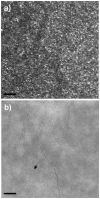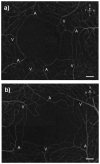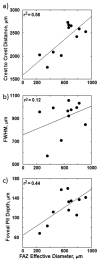Foveal avascular zone and its relationship to foveal pit shape
- PMID: 22426172
- PMCID: PMC3348263
- DOI: 10.1097/OPX.0b013e3182504227
Foveal avascular zone and its relationship to foveal pit shape
Abstract
Purpose: To investigate the retinal microvasculature at the fovea and peripheral retina in humans using an adaptive optics scanning laser ophthalmoscope (AOSLO) and to examine the association of foveal avascular zone (FAZ) and foveal pit morphology.
Methods: Retinal imaging of the foveal capillary network was performed on 11 subjects (15 eyes; age range 20 to 54 years) with an AOSLO. Standard deviation maps of the AOSLO images were generated from ∼10 to 30 frames, producing high-resolution maps delineating the complete capillary distribution of the retina. Foveal pit morphology was investigated in the same subjects by using a spectral domain optical coherence tomography. In an additional subject, only a relatively large retinal vasculature map was obtained using AOSLO.
Results: A well-demarcated FAZ was seen in 11 subjects tested with foveal capillary imaging. There was considerable individual variation in the size and shape of the FAZ. The mean FAZ area and mean FAZ effective diameter were 0.33 mm(2) and 622 μm, respectively. Foveal thickness was found to be negatively correlated with the FAZ effective diameter.
Conclusions: The structure of the capillary network could be evaluated in the fovea and parafovea using our approach. We find that a smaller FAZ is associated with a narrower foveal pit opening and a thicker fovea.
Figures








References
-
- Provis JM, Sandercoe T, Hendrickson AE. Astrocytes and blood vessels define the foveal rim during primate retinal development. Invest Ophthalmol Vis Sci. 2000;41:2827–36. - PubMed
-
- Springer AD, Hendrickson AE. Development of the primate area of high acuity. 1. Use of finite element analysis models to identify mechanical variables affecting pit formation. Vis Neurosci. 2004;21:53–62. - PubMed
-
- Springer AD, Hendrickson AE. Development of the primate area of high acuity. 2. Quantitative morphological changes associated with retinal and pars plana growth. Vis Neurosci. 2004;21:775–90. - PubMed
-
- Springer AD, Hendrickson AE. Development of the primate area of high acuity, 3: temporal relationships between pit formation, retinal elongation and cone packing. Vis Neurosci. 2005;22:171–85. - PubMed
-
- Bradley A, Zhang H, Applegate RA, Thibos LN, Elsner AE. Entoptic image quality of the retinal vasculature. Vision Res. 1998;38:2685–96. - PubMed
Publication types
MeSH terms
Grants and funding
LinkOut - more resources
Full Text Sources
Other Literature Sources

